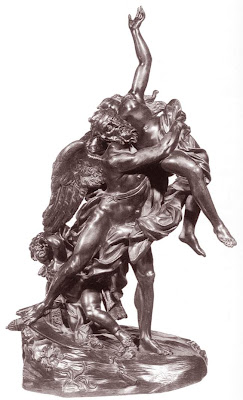Lucky me - I am now working close enough to head to the Art Gallery of Ontario for a quick look at lunchtime. Little by little and room by room I am going to work my way through the building. It's great - no need to rush.
Although I didn't realize the parallels at the time, both of the artists that caught my eye today are young Canadians (Boyle is from Toronto and Altmejd from Montreal), and both were skillfully incorporating mirrors into their work...
I just wish I could take photos, though, because the ones available for download online don't really provide the details I want to talk about. Damn security guards!
 Anyway, this photo of 'The Index' by artist David Altmejd on the right gives you an idea of the scale of the work. The bird costumed as man lets you know you are entering into a dream-zone. The sheer size of the installation beckons you to wander through passages, secret rooms and corridors. What the photo doesn't provide is the experience of the wonderful, creepy minutia that gives it such a phantasmagorical feel: the shattered mirrors, the owls, the song birds, the mushrooms, the gold chains the birds have woven through the wood... The mirrors in this piece are a great touch; I get to experience the art through wandering and I literally become part of the art through my reflection - but only for as long as I'm standing there, reflecting. I get a sense that maybe I'm pretty small, pretty fleeting.
Anyway, this photo of 'The Index' by artist David Altmejd on the right gives you an idea of the scale of the work. The bird costumed as man lets you know you are entering into a dream-zone. The sheer size of the installation beckons you to wander through passages, secret rooms and corridors. What the photo doesn't provide is the experience of the wonderful, creepy minutia that gives it such a phantasmagorical feel: the shattered mirrors, the owls, the song birds, the mushrooms, the gold chains the birds have woven through the wood... The mirrors in this piece are a great touch; I get to experience the art through wandering and I literally become part of the art through my reflection - but only for as long as I'm standing there, reflecting. I get a sense that maybe I'm pretty small, pretty fleeting. Around the corner from 'The Index' are two small porcelain pieces by artist Shary Boyle. Again, you can't really see the mirrors here, the photos don't focus on them. If you visit the artist's site you'll get a better view.
The piece above is called 'The rejection of Pluto', and the one to the below is called 'To colonize the moon'. Both were brilliantly displayed with bronzes by Foggini, renowned Florentine sculptor from the late baroque period, depicting the same mythological scenes. (The bronze below is 'Time ravishing beauty', I couldn't find images of the ones in the AGO collection but they are of the same style).
The contrasts between the two approacches are powerful: metallic and rigid vs. bright and reflective; unyielding bronze next to fragile porcelain; vibrant, bright colour vs. monochromatic, earthy tones; male figures unquestioningly conquering the female, positioned next to the conquered females, but this time with questioning and challenging looks on their faces. In Boyle's pieces the mirrors function to pull the viewer into the scene as witnesses... or is it accessories... to the crime.

The piece above is called 'The rejection of Pluto', and the one to the below is called 'To colonize the moon'. Both were brilliantly displayed with bronzes by Foggini, renowned Florentine sculptor from the late baroque period, depicting the same mythological scenes. (The bronze below is 'Time ravishing beauty', I couldn't find images of the ones in the AGO collection but they are of the same style).
The contrasts between the two approacches are powerful: metallic and rigid vs. bright and reflective; unyielding bronze next to fragile porcelain; vibrant, bright colour vs. monochromatic, earthy tones; male figures unquestioningly conquering the female, positioned next to the conquered females, but this time with questioning and challenging looks on their faces. In Boyle's pieces the mirrors function to pull the viewer into the scene as witnesses... or is it accessories... to the crime.



No comments:
Post a Comment